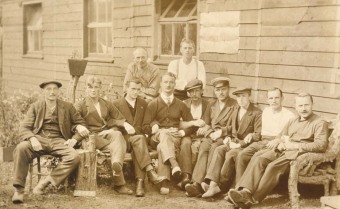
The internees were ordinary men who, by accident of birth, found their lives turned upside down. For some depression, or “barbed wire disease”, would drag them down as they remained prisoner within a barbed wire compound of about 100 yards square whilst the world went to war, missing their families and their homes in their own “no-mans-land”. For others, this period away from their normal life did provide new opportunities, led to new skills being learned which would change their lives or indeed the lives of others. We are delighted to share just a few of the stories we have been researching and collating below such as a certain Mr Joseph Pilates.
These stories come from the work within our Database Archive, which incorporates a list of WW1 Internees interned within the Camps of the British Isles, including Knockaloe Camp Internees and Douglas Camp Internees on the Isle of Man, as well as the camps based in Britain such as Alexandra Palace Internees. Our work collates the stories behind every internee and our Visitors Centre seeks to provide a central point of reference for descendants of any enemy alien interned in WW1.
We trace each internee through their experience of WW1 internment from their initial arrest and as the moved from Camp to Camp. The vast majority of the internees (over 31,000) spent some or all of that internment at Knockaloe Camp or Douglas Camp on the Isle of Man. We also look at their experiences within all of the Camps within the British Isles and seek to help descendants understand their own family's experiences of that time.
We are continuously collating those stories and fragmentary information received about aliens interned in the British Isles, held both on and off the Isle of Man. Our Database, Archive and our fabulous collections are ever growing, they are and will remain offline to ensure such a wealth of information collected and collated by the Charity and kindly shared by descendants, private collectors and other archives, remain safe and not open to commercialisation by others, so that you know that what you share with us is treated with care at the Visitor Centre in order to tell these stories on behalf of the families. We should also love to hear from you if you have a story of an internee to add to our archive so these can be retold to future generations, please do share any images of the internee and images of any letters and artefacts you may have. Contact us by email at info@knockaloe.im.
To find out more about your internee ancestor and their experience of internment, why not book an Internee Review as part of your visit to the Centre. To ensure we have time to carry out the prior research and our researcher is on island and available on the day please contact us well in advance of planning your visit via info@knockaloe.im and we shall be delighted to carry out one to one research in advance of your visit to have it ready for you upon arrival so we can help you gain the most from your experience. For information about booking an Internee Review and Visitor Centre opening times, please click here
To mark the centenary of the day the first internees arrived at Knockaloe Camp on 17 November 1914, on 17 November 1914 we launched this website and moved the first of our internees, Karl Fahlbusch into our internees page.
Below is his story, together with some of the other occasional stories about internees which we have featured on our Facebook page. These are just a very small sample of the stories we are continuously researching plus those stories we tell as part of the Visitors Centre. To learn more about these featured internees, click on the photographs below. Do contact us if you have anything to add to their stories, or if you have a new story to add, or if you are a descendant and would like to book an Internee Review at the Centre.
Contact us by email at info@knockaloe.im